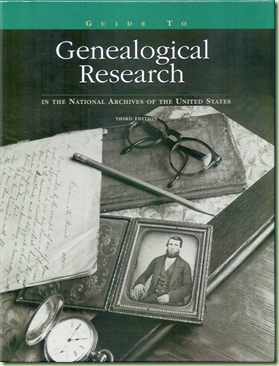I recently made my first visit to the National Archives and Record Administration (NARA). This is one in a series of articles inspired by that visit to help you make your first visit to the National Archives.
Genealogical Research
 I mentioned in a previous article that using the Guide to Genealogical Research in the National Archives of the United States, third edition, is one of the best ways to prepare for a trip to the National Archives and Records Administration (NARA). It's a great guide to NARA records, even when accessing records online or on microfilm. I think I even volunteered to review the contents of the book and give examples of using it. So, here we go...
I mentioned in a previous article that using the Guide to Genealogical Research in the National Archives of the United States, third edition, is one of the best ways to prepare for a trip to the National Archives and Records Administration (NARA). It's a great guide to NARA records, even when accessing records online or on microfilm. I think I even volunteered to review the contents of the book and give examples of using it. So, here we go...
Book Contents
The table of contents of Genealogical Research gives a nice overview of the record types most likely to contain genealogically relevant material. The sections and chapters are:
INTRODUCTION 1
SECTION A Population and Immigration
Chapter 1 Census Records 13
Chapter 2 Passenger Arrivals and Border Crossings 49
Chapter 3 Naturalization Records 85SECTION B Military Records
Chapter 4 Records of the Regular Army 109
Chapter 5 Service Records of Volunteers 125
Chapter 6 Naval and Marine Service Records 153
Chapter 7 Pension Records 167
Chapter 8 Bounty Land Warrant Records 179
Chapter 9 Other Records Related to Military Service 189SECTION C Records Relating to Particular Groups
Chapter 10 Records of Civilians During Wartime 199
Chapter 11 Records of Native Americans 211
Chapter 12 Records of African Americans 237
Chapter 13 Records of Merchant Seaman 257
Chapter 14 Records of Civilian Government Employees 269SECTION D Other Useful Records
Chapter 15 Land Records 285
Chapter 16 Claims Records 305
Chapter 17 Records of the District of Columbia 317
Chapter 18 Miscellaneous Records 327
Chapter 19 Cartographic Records 339APPENDIX 1 List of Record Groups Cited 351
APPENDIX 2 List of Microform Publications Cited 353
Knowing the topics mentioned in the table of contents, if you don't have access to Genealogical Research, you can use online publications that cover these topics. Or search the NARA website using the search box in the upper-right corner.
Introduction
The Introduction Section contains basic information to make you more productive and prevent you from wasting time looking for records that NARA doesn't have.
Section I.1 talks about the "value and limitations of Federal records." NARA records are for Federal records only. For example, vital records are kept at the local or state level, so NARA doesn't have them. And it has no colonial era records. NARA's primary mission is to serve federal agencies, so to find an ancestor in NARA records, you need to think about how an ancestor would have interacted with the federal government.
In section I.3, "Record Organization," we read that records are arranged as best served the creating agency, not the genealogist. That's why this book and other finding aids are necessary. NARA records are organized by record groups (RGs) by creating agency. Record groups are divided into series. And series are divided into items.
Section I.5 is titled, "NARA Microform Publications." NARA publishes records in two microforms: microfilm and microfiche. Their publication program "has been assisted by the generous sharing of film produced by other groups, such as the Genealogical Society of Utah [FamilySearch, International]." Many NARA microform publications are available in the research rooms at their regional archives. Some of these can be purchased by individuals. Microform publications are cited in Genealogical Research and other finding aids by number and title. A typical citation is M694, Index to Compiled Service Records of Volunteer Soldiers Who Served from 1784 to 1811, 9 rolls.
The first letter of the microfilm number divides the publications into five categories.
| M | Most M publications cover an entire series. | NARA |
| A | These publications are numbered in the same sequence [as in the original records?]. They do not always reproduce a complete series, but may contain segments by date or subject. | May be copies produced by other Federal agencies. |
| T | ||
| P | Preservation purposes. | |
| C | Contractors produced but NARA can use after 7 yrs. |
Next time I'll provide usage examples from Section B, Military Records.
No comments:
Post a Comment
Note: Only a member of this blog may post a comment.